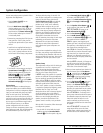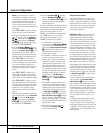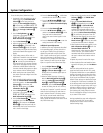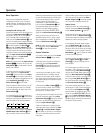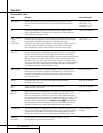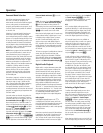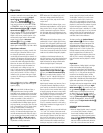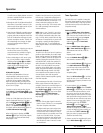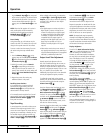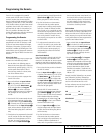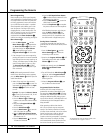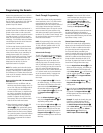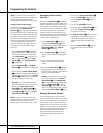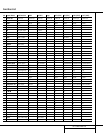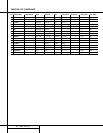
25 OPERATION
Operation
120 will return to digital playback as soon as
the data is available and when the machine
is in a standard play mode.
2.Although the AVR 120 will decode virtually all
DVD movies, CDs and HDTV sources, it is pos-
sible that some future digital sources may not
be compatible with the AVR 120.
3. Note that not all digitally encoded programs
contain full 5.1-channel audio. Consult the
program guide that accompanies the DVD or
laser disc to determine which type of audio
has been recorded on the disc. The AVR 120
will automatically sense the type of digital
surround encoding used and adjust to
accommodate it.
4. When a digital source is playing, you may not
be able to select some of the analog
surround modes such as Dolby Pro Logic II,
Dolby 3 Stereo, Hall,Theater or Logic 7.
5. When a Dolby Digital or DTS source is play-
ing, it is not possible to make an analog
recording using the
Tape ™ and Video 1
Audio Outputs
∞. However, the digital
signals will be passed through to the
Optical ª and Coaxial ‚ Digital
Audio Outputs
.
PCM Audio Playback
PCM (Pulse Code Modulation) is the non-
compressed digital audio system used for
compact discs and laser discs. The digital circuits
in the AVR 120 are capable of high-quality
digital-to-analog decoding, and they may be
connected directly to the digital audio output
of your CD or LD player.
Connections may be made to either the rear
panel
Optical or Coaxial Inputs de or the
front panel
Optical or Coaxial Digital Inputs
#$.
To listen to a PCM digital source, first select the
input for the desired source (e.g., CD). Next,
press the
Digital Input Selector Úp and
then use the
⁄
/
¤
Buttons mq on the
remote, or the
Selector Buttons5 on the
front panel, until the desired choice appears in
the
Main Information Display F.
When a PCM source is playing, the
PCM
Indicator A will light. During PCM playback,
you may select any surround mode except
Dolby Digital or DTS.
Playback from PCM sources may also benefit
from the Logic 7 Mode. When playing back a
surround-encoded PCM source, such as an LD
or surround-encoded CD, use the Logic 7 C or
Cinema mode. When playing true stereo
recordings, use the Logic 7 M or Music mode
for a wider soundstage and increased rear-
channel ambience.
NOTE: When a Logic 7 mode is in use with a
digital input source which has another mode
for its default, that default mode, rather than
Logic 7, will be used by the AVR after the digi-
tal bitstream is interrupted for any reason such
as stopping or pausing the digital playback.
Note, also, that Logic 7 is not available with
digital playback unless a two-channel bitstream
is in use.
MP3 Audio Playback
The AVR 120 is one of the few A/V receivers to
provide on-board decoding for the MP3 audio
format used by computers and portable audio
devices. In addition, some new CD players are
capable of playing back optical discs that are
recorded with MP3, rather than standard CD
audio information. By offering MP3 decoding,
the AVR 120 is able to deliver more precise
conversion of the digital signals to an analog
output, along with the benefits of listening to
the MP3 audio through the AVR 120’s high-
current amplifier and the speakers from your
surround system, rather than the smaller
speakers and low-powered amplifiers typically
used with computers.
To take advantage of the AVR 120’s MP3 capa-
bilities, simply connect the PCM output of a
computer’s sound card or the PCM output of a
portable digital audio device to either the rear
panel
Digital Inputs de or the front panel
Digital Inputs #$.As soon as the digital
signal is available, the
MP3 Bitstream
Indicator
A will light, and the audio will
begin playing.
NOTES:
• The AVR 120 only plays signals in the MP3
(MPEG 1/Layer 3) format. It is not compatible
with other computer audio codecs.
• The digital audio input signal may be either
optical or coaxial, but it must be PCM in the
S/P-DIF format. Direct connection of USB or
serial data outputs is not possible, even if the
signals are in the MP3 format. If you have
any questions about the data output format
from your computer or a sound card, check
with the device’s owner’s manual or contact
its manufacturer.
Tuner Operation
The AVR 120’s tuner is capable of tuning AM,
FM and FM Stereo broadcast stations. Stations
may be tuned manually, or they may be stored
as favorite station presets and recalled from a
30-position memory.
Station Selection
1. Press the AM/FM Tuner Select Button
g on the remote to select the tuner as an
input. The tuner may be selected from the
front panel by either pressing the
Input
Source Selector
! until the tuner is
active or by pressing the
Tuner Band
Selector
9.
2. Press the
AM/FM Tuner Select Button
g or Tuner Band Selector 9 again to
switch between AM and FM so that the
desired
frequency band is selected.
3. Press the
FM Mode Button
@
s to
select manual or automatic tuning.
When the
AUTO Indicator R is illuminated
in the
Main Information Display Û the
tuner will stop only at those stations that
have a strong enough signal to be received
with
acceptable quality.
When the
AUTO Indicator R is not illumi-
nated, the tuner is in a manual mode and
will stop at each frequency increment in the
selected band.
4. To select stations, press the
Tuning
Selector Button
8
u. When the AUTO
Indicator
R is illuminated, press the button
for two seconds and then release to cause
the tuner to search for the next highest- or
lowest-frequency station that has an accept-
able signal. When tuning FM stations in the
Auto mode, the tuner will select only stereo
stations. To tune to the next station, press
the button again. If the
STEREO
Indicator P is not illuminated, tap the
Tuning Selector Button
8
u to
advance one frequency increment at a time,
or press and hold it to locate a specific sta-
tion. When the
TUNED Indicator Q
lights, the station is properly tuned and
should be heard with clarity.
5. Stations may also be tuned directly by press-
ing the
Direct Button t, and then press-



